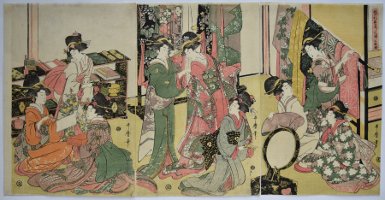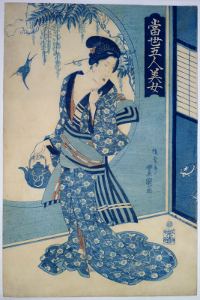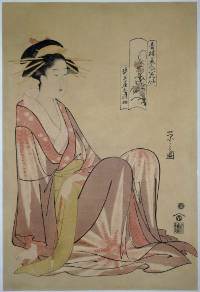Katsukawa SHUNSHO (1726-1792)

Click here to view image full size.
A chuban print from a set of three: Sanseki waka, “Three Evening Poems.” In this case interpreting a poem by Jakuren hoshi (1139-1202). The poem reads: Sabishisa wa / sono iro to shimo / nakarikeri / makitatsu yama no / aki no yugare, Loneliness / is not / any particular colour – / a mountain of black pines / on an autumn evening. The other two prints probably have poems by Teika and Saigyo. Shows beauties on a balcony admiring the pines in the distance. Published c. early 1770s. Ex collection Erik Holmberg. Rare.
Very good impression. Particularly good colour with pigments that have usually turned. Very good condition. Signed Shunsho ga.
Status: Sold
Isoda KORYUSAI (1735-1790)

Click here to view image full size.
A pillar print, hashira-e, of a beauty after a bath cooling herself with a fan. A cat looks up adoringly from below. Above her is a temple bell wind chime, often hung in the summer. Masanobu laid claim to have invented the pillar print format. Roger Keyes has suggested that, because many large format prints from the 1740s were printed using two blocks of wood, there was a tendency for the blocks to separate during use, giving rise to the hashira-e shape. Probably the most interesting format in that the restrictions often led to creative compositions. And figures sometimes partially exit or enter from the side, giving weight to the theory of separating blocks of wood. Certainly, these prints were hung on pillars in houses, and because of this they often come browned, faded or damaged. Koryusai was the artist par excellence when it comes to pillar prints. Rare.
Very good impression and colour. Slight toning, but in very good condition for such a print. Signed Koryusai ga.
Status: Sold
Katsukawa SHUNCHO (Active 1780-1795)

Click here to view image full size.
A chuban print from a set of five designs: Imoseyama gomai tsuzuki, “Imoseyama, a Set of Five Prints.” Shows two court beauties and an attendant. Based on the Bunraku play Imoseyama onna teikin, “Husband and Wife Mountain: An Exemplary Tale of Womanly Virtue” which was performed for the first time in 1771. It was then adapted for the Kabuki theatre. The play is in five acts.
Very good impression, colour and condition. Signed Shuncho ga.
Status: Sold
Utagawa SADAHIDE (1807-1873)
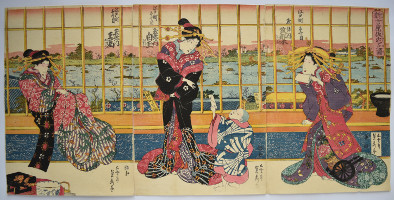
Click here to view image full size.
A triptych, Shin Yoshiwara karitaku no zu, “Temporary Lodgings of the New Yoshiwara.” Shows the courtesans Shiratama, Masanagi, and Tamakazura of the Tamaya House before a latticed window overlooking the Ryogoku River. The Tamaya was one of the best known brothels. Their kamuro are listed beside their names. Published c. 1843-7 by Yamaguchiya Tobei. Rare: I cannot locate another impression.
Very fine impression, colour and condition.Signed Gountei Sadahide ga.
Status: Sold
Kikugawa EIZAN (1787-1867)
Click here to view image full size.
The courtesan Biso of the Ogi House holding a brush up to a snow sculpture of Daruma. Snow from a Snow, Moon, Flowers set: Seiro bijin setsugekka. Published by Kawaguchiya Uhei, c late 1810s.
Fine impression. Very good colour. Fine condition: Full size with extra paper. Signed Eizan hitsu.
Status: Sold
Kikugawa EIZAN (1787-1867)
Click here to view image full size.
Winter from a set Furyu bijin kodakara awase, “Elegant Beauties and Precious Children.” Shows a beauty carrying one child and looking down at another with a large snowball. Published by Matsumura Yahei, c late 1810s.
Fine impression. Very good colour. Fine condition: Full size with extra paper. Signed Eizan hitsu.
Status: Sold
Tsukioka YOSHITOSHI (1839-1892)

Click here to view image full size.
Kemu-so: Kyowa nenkan naishitsu no fuzoku, “Looking Smoky:The Appearance of a Housewife of the Kyowa Era.” From the set: Thirty-Two Aspects of Women published by Tsunashima Kamekichi, 1888. Shows a housewife fanning a smoldering fire probably intended to repel summer insects. The best design from the set.
Very fine impression, colour and condition of the first edition. The gradation and printing of the smoke is particularly accomplished. Signed Yoshitoshi ga.
Status: Sold
Kitao MASANOBU (Santo KYODEN) (1761-1816)

Click here to view image full size.
One double-oban design from the most sumptuous album ever produced: Yoshiwara keisei: Shin bijin awase jihitsu kagami, “A Mirror of New Yoshiwara Courtesans with Samples of Their Calligraphy.” Published by Tsutaya Juzaburo, 1784. Shows courtesans viewing calligraphic scrolls. Seven double-oban designs were published in album form, although the original intention was for a larger set. Signed on two sheets Kitao sensai Masanobu.
Fine impression. Extremely good colour. Centre fold (as always), several very small wormholes and minor marks, but otherwise in very good condition.
Status: Sold
Hosoda EISHI (1756-1829)

Click here to view image full size.
The courtesan Shizuka of the Shizutama-ya from the set of six prints Seiro bijin rokkasen, “Six Poems on Yoshiwara Beauties as Flowers.” One of the most beautiful sets of this period. Published 1794 by Nishimuraya Yohachi (Eijudo). The centre cartouche has a seasonal bloom, in this case the pink which was the emblem of Shizuka. See Klaus Brandt, Hosoda Eishi, 1977, 51, no. 172. Another impression was in the Popper sale catalogue, no. 138 and the impression from the Museum fur Ostasiatische Kunst, Berlin, is illustrated in the 1974 Tokyo Exhibition catalogue, no. 146.
Fine impression. Very good colour and condition. Yellow ground and mica on collar. Signed Eishi zu.
Status: Sold
Hosoda EISHI (1756-1829)

Click here to view image full size.
The parading courtesan Yosooi of Matsubaya with her kamuro Tomeki and Nioi. Not listed in Brandt. Published by Nishimuraya Yohachi (Eijudo) c 1800. She must have been a popular courtesan as she is depicted on many prints by various artists around this date.
Fine impression. Very good colour: Pale yellow ground. Very slight centre fold, otherwise very good condition. Signed Eishi zu.
Status: Sold
Utagawa TOYOKUNI (1769-1825)

Click here to view image full size.
A triptych showing the interior of a mansion. In the centre the head of the household, a young male, surrounded by his female attendants. This most likely shows the Setsubun – a ritual of bean-throwing to clear out the evil from a house on the day before the beginning of spring which was considered New Year’s eve. There are impressions in the MFA Boston (11.13833-5, 21.7798-800) and MET (JP201). Published by Iwatoya Kisaburo. The MET and MFA give a date as c 1791-4 but the signature better fits a date of c 1800.
Very good impression. Exceptional colour – better even than the other illustrated examples. Small restoration on last sheet, otherwise very good condition with extra paper around. Signed Toyokuni ga. Rare.
Status: Sold
Utagawa KUNISADA (1786-1865)

Click here to view image full size.
Fuji kaeri no yudachi, “Sudden Shower on the Way Home.” Shows a beauty hunched under an umbrella against the rain. From a set of ten prints Tosei bijin awase, “Contest of Present-day Beauties.” She is returning from the Fuji festival celebrating the annual opening of Mount Fuji to pilgrims on the first day of the sixth month. (The straw snake in the cartouche, top right, is a souvenir from the festival.) Miniature mounds representing Fuji were made in locations such as Asakusa and Komagome and could reach 39 ft. high. Published by Moritaya Hanzo, 1827. A fine design.
Fine impression. Very slight “turning” of the fujitive blue on the umbrella, otherwise fine colour. A later edition was published replacing the beautiful pigment on the umbrella with a coarse dark blue pigment. Fine condition. Signed Gototei Kunisada ga.
Status: Sold
Kitagawa SHIKIMARO (Fl. c 1810)

Click here to view image full size.
The courtesan Oi of the Ebiya smoking a pipe and admiring her reflection in a mirror. From a set Imayo onna kasen, sanjurokuban tsuzuki, “Thirty-six Modern Female Poets.” In the panel to the left is an example of her calligraphy with the names of her kamuro: Miyako and Sakuro. Her sumptuous kimono is decorated with fans – the emblem of the house of Ebiya. Probably a pupil of Tsukimaro carrying on the tradition of Utamaro. Published by Nishimuraya Yohachi (Eijudo), 1813.
Very good impression, colour and condition. Signed Shikimaro ga.
Status: Sold
Utagawa TOYOKUNI II (1777-1835)

Click here to view image full size.
An aizuri (blue) print from a set Tosei bijin hana-awase, “Beauties of the Latest Fashion Compared to the Beauty of Flowers.” In this case kikyo flowers – the Chinese bellflower. Aizuri prints were the outcome of avoiding intermittent edicts promulgated by the bakufu prohibiting the number of blocks that could be used. The aim being to curb excesses, raise moral standards and encourage thrift. Published by Shimizo, c. late 1820s. Three other prints from set are in the Brooklyn Museum of Art, 76.151.13; 14; 15.
Fine impression, colour and condition. Signed Toyokuni ga.
Status: Sold
Kitao MASANOBU (1761-1816)

Click here to view image full size.
Shows a couple caught in a downpour, the man shielding his companion with an umbrella. They are on the shore of Lake Biwa, northeast of Kyoto. In the distance can be seen the famous ancient pine tree in the grounds of the Karasaki Shrine. An unsigned (few of Masanobu’s prints are signed or have publisher’s seals) chuban set Furyu Omi hakkei, “Fashionable Eight Views of Omi,” this being night rain at Karasaki. Wrote under the name Santo Kyoden. Was also a painter, and illustrator of his own novels while owning a tobacco accessory shop. Published c. 1783. Rare.
Fine impression and colour. Small backing paper at top two corners, otherwise fine condition.
Status: Sold
Utagawa TOYOHIRO (1773-1828)

Click here to view image full size.
An oban print with title: Ryukyujin no zu, “Pictures of People from Ryukyu.” (A chain of Japanese islands stretching southwest from Kyushu to Taiwan.) The Ryukyuans had a specific culture, one element of which was to select young boys (gakudoji) from the upper classes of the capital to be apprenticed to perform as women in dances during the processionals to Edo. These processions of feudal lords, often with elaborate retinues, were required by the Shogun and were a way of keeping the lords submissive and cash-strapped as the journeys were extremely expensive. The gakudoji are usually shown riding a white horse with an attendant holding a large umbrella (a colourful parasol in this case). Another (heavily trimmed) design from this set is in the Ritsumeikan University, Kyoto, Japan. Toyohiro seems to have had a particular interest in these boys as he designed a number of other prints on this subject. Of the utmost rarity: I have not seen another print from this set in 50 years of dealing. Published by Shimizu, c. 1804.
Fine impression and colour with strong yellow ground. Possibly slightly trimmed (?), otherwise very good condition. Signed Toyohiro ga.
Status: Sold
Kikugawa EIZAN (1787-1867)

Click here to view image full size.
The first sheet from one of Eizan’s most famous triptychs: Furyu yusuzumi san bijin, “Three Fashionable Beauties Cooling Off in the Evening.” Shows a teahouse waitress seated outside her establishment with silhouettes of customers showing on the shoji screen. Published by Yamadaya Shobei, c. 1814-17.
Fine impression, colour and condition. Signed Kikugawa Eizan hitsu.
Status: Sold
Utagawa KUNIYOSHI (1797-1861)
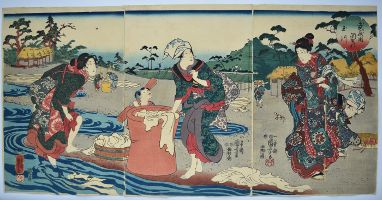
Click here to view image full size.
A triptych showing three women washing clothes in a stream from a set Six Tama [Jewel or Crystal] Rivers, this being the Chofu Crystal River (in fact the Tamagawa that flowed into Edo Bay). Musashi no kuni Chofu no Tamagawa. The set published by Sanoya Kihei, c 1847. The complete set is illustrated in The Baur Collection, Matthi Forrer, vol. II, 1994, nos G396-G401 (this being G397).
Very good impression, colour and condition. Signed Ichiyusai Kuniyoshi ga.
Status: Sold
Utagawa KUNISADA (1786-1865)
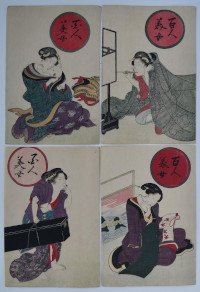
Click here to view image full size.
Four koban surimono-style prints from a set Hyakunin bijo, “One Hundred Beauties.” No publisher’s seal but published by Mikawaya Seiemon (who specialised in these prints), c late 1820s. Kunisada designed a number of such sets in this format.
Fine impressions, colour and condition.
Status: Sold
Keisai EISEN (1790-1848)

Click here to view image full size.
Three koban surimono-style prints from a set Imayo sanjurokkasen, “Thirty-six Selected Pictures.” Published c late 1820s.
Fine impressions, colour and condition.
Status: Sold
Kubo SHUNMAN (1757-1820)

Click here to view image full size.
Mishima, or Toi, Province of Settsu. The best desigm from an exquisite set of six prints showing graceful young women, girls and, in two instances, young men representing the Six Crystal (Tama) Rivers. These streams were noted for the purity of their water. The prints are in benigirai style, “red avoiding,” a technique pioneered by Shunman, Eishi and Shuncho. Shows a seated girl fulling cloth (hence Toi which is the alternative name of the river and the word for beating cloth) with three other beauties near the village of Mishima. A light shower passes by in the background. Shunman, a man of great sophistication, designed only a few prints before concentrating on surimono and printing and issuing some of the finest in this format. (See The Japanese Print: A New Approach, J. Hillier, pp. 102-104 where he says “Probably no artist except Choki has achieved so high a reputation on such a small number of prints.”) He also excelled at painting, book illustration and light verse. Published by Fushimiya Zenroku, c 1787. (A later edition was published by Tsutaya with less harmonious colours.) One of the most beautiful 18th century sets, and together with a night triptych showing people returning from a poetry reading, is considered his masterpiece. The complete set (trimmed) is illustrated in the Gale Catalogue Of Japanese Paintings & Prints, J. Hillier, Routledge, 1970, number 133 (a) – (f). Provenance: Originally purchased from me in 2008. Rare.
Fine impression. The centre female’s kimono blind-printed. Very good colour: printed only in tones of grey, light yellow and light pink, with touches of light red on the tree. Very small repaired wormhole, otherwise extremely good condition with extra paper at left. Probably untrimmed (whereas illustrated examples all seem to be trimmed somewhere). Signed Shunman with seal Shunman.
Status: Sold
Kubo SHUNMAN (1757-1820)

Click here to view image full size.
Chobu, Province of Musashi from an exquisite set of six prints showing graceful young women, girls and, in two instances, young men representing the Six Crystal (Tama) Rivers. These streams were noted for the purity of their water. The prints are in benigirai style, “red avoiding,” a technique pioneered by Shunman, Eishi and Shuncho.Shows a girl washing stripes of cloth in the stream. In fact, this design conjoins with the previous print in the set of six prints. Shunman, a man of great sophistication, designed only a few prints before concentrating on surimono and printing and issuing some of the finest in this format. (See The Japanese Print: A New Approach, J. Hillier, pp. 102-104 where he says “Probably no artist except Choki has achieved so high a reputation on such a small number of prints.”) He also excelled at painting, book illustration and light verse. Published by Fushimiya Zenroku, c 1787. (A later edition was published by Tsutaya with less harmonious colours.) One of the most beautiful 18th century sets, and together with a night triptych showing people returning from a poetry reading, is considered his masterpiece. The complete set (trimmed) is illustrated in the Gale Catalogue Of Japanese Paintings & Prints, J. Hillier, Routledge, 1970, number 133 (a) – (f). Provenance: Originally purchased from me in 2008. Rare.
Fine impression with some blind-printing. Very good colour: printed only in tones of grey, light yellow and light pink, with touches of light red on the tree. Very small repaired wormhole, otherwise extremely good condition with extra paper at left. Probably untrimmed (whereas illustrated examples all seem to be trimmed somewhere). Signed Shunman with seal Shunman.
Status: Sold
Kitagawa UTAMARO (1754-1806)

Click here to view image full size.
The courtesan Hitomoto of the Daimonjiya House, Daimonjiya uchi Hitomoto from a set Yukun gosekku, “Courtesans for the Five Festivals.” She stands beside a clothes rack with an elaborate costume patterned with a suite of armour (probably indicating the Boys’ Festival, 5th day of the 5th month), Published 1805 by Wakasaya Yoichi (Jakurindo).
Fine impression. Very good colour with beautiful oxidation of the orange pigment. Probably slightly trimmed at left, otherwise fine condition. Signed Utamaro hitsu.
Status: Sold
Kitao MASANOBU (Santo KYODEN) (1761-1816)

Click here to view image full size.
One double-oban design from the most sumptuous album ever produced: Yoshiwara keisei: Shin bijin awase jihitsu kagami, “A Mirror of New Yoshiwara Courtesans with Samples of Their Calligraphy.” Published by Tsutaya Juzaburo, 1784. Shows courtesans viewing calligraphic scrolls. Seven double-oban designs were published in album form, although the original intention was for a larger set. Signed on two sheets Kitao sensai Masanobu.
Fine impression and colour. Centre fold (as always), otherwise very good condition.
Status: Sold
Okumura MASANOBU (1686-1764)

Click here to view image full size.
A large benizuri-e oban (16.75 x 12 in) showing a pair of lovers in the guise of komuso (medicant monks). They walk in high geta and have a black monk’s stole draped around their shoulders. They are playing the classic komuso tune renbo nagashi on their shakuhachi. He wears the deep sedge tengai hat. A hokku verse is on the right. Provenance: Ex collection Henri Vever, sealed bottom right. Sold Sothebys, Highly Important Japanese Prints from the Henri Vever Collection: Final Part, 30/9/1997, lot 6. Extremely rare: Probably the only recorded impression.
Very good impression and colour. Wormhole expertly repaired at right edge, otherwise very good condition. Signed Hogetsudo Tanchosai Okumura Bunkaku Masanobu shohitsu with two seals Tanchosai and Okumura Masanobu.
Status: Sold
Utagawa KUNISADA (1786-1865)

Click here to view image full size.
A triptych from a series Imayo mitate shi-no-ko-sho, “An Up-to-Date Parody of the Four Classes.” Here: Shokunin, “Artisans.” Shows the whole process of print production, albeit in reality women did not do this work. Published by Uoya Eikichi, 8/1857. A must for any serious collection of Japanese prints. There are only two other designs showing the process of producing prints. Extremely rare.
Very good impression. Some fading and trimming, but generally good condition. Signed Toyokuni ga.
Status: Sold
Kikugawa EIZAN (1787-1867)

Click here to view image full size.
A triptych Furyu onna ryoushi, “Fashionable Fishing Women.” Shows beauties on the seashore collecting fish and loading them onto a boat for market. In the background, fishermen with nets. Published by Iwatoya Kisaburo (Eirindo), c 1817. The Japanese love seafood and, being surrounded by water, there is an abundance of fish and crustaceans as anyone who has visited the central fish market in Tokyo can attest to.
Fine impression. Very good colour. Small areas of expertly repaired wormholes, otherwise very good condition. Signed Eizan hitsu.
Status: Sold
Keisai EISEN (1790-1848)

Click here to view image full size.
A triptych showing three courtesans from the Tamaya House: On first sheet Koyuki playing the kokyu; on the second Hanamurasaki playing the koto; and on the third Hanakazura playing the shamisen. Published c 1830.
Fine impression with excellent colour. Some expert edge restoration, otherwise very good condition with extra paper around.
Status: Sold
Utagawa TOYOKUNI (1769-1825)
Click here to view image full size.
Furyu rokkasen, “Fashionable Six Poets.” One sheet from a set of three that can be viewed separately or as a triptych. Shows the famous Heian period waka poets Ono no Komachi and Ariwara no Narihira together with an attendant. Two famous poems by them above in gold clouds, hinting at the archaising motif. Published by Nishimuraya Yohachi , c 1802. Originally purchased from me in 1976.
Fine impression and colour. Very good condition with yellow ground and gold printed at the top. Signed Toyokuni ga.
Status: Sold
Hosoda EISHI (1756-1829)
Click here to view image full size.
A parading courtesan, Senzan of the Choji-ya house, with her two kamuro, Isieji and Hanaji. From a set of seven prints Seiro moyo awase, “A Comparison of Patterns of the Green houses.” Published by Eijudo, 1796-7. The title on a teacup. A luxurious yellow ground. See Klaus J. Brandt, 1977, no. 263, p. 146. A fine set. Rare.
Fine impression. Extremely fine, unfaded colour. Fine condition: Untrimmed with extra paper at left. A benchmark example for prints of this period. Signed Eishi zu.
Status: Sold
Tsukioka YOSHITOSHI (1839-1892)
Click here to view image full size.
Omoshiro-so: Bunsei nenkan okujochu no fuzoku, “Looking Amused: The Appearance of a High-ranking Maid in the Bunsei Era” ( 1818 – 1830 ). From the set: Thirty-two Aspects of Women published by Tsunashima Kamekichi, 1888. Shows a maid to the concubine of a daimyo looking over a balcony.
Superb impression of the first edition. Very fine colour and condition with the extra paper at left edge and the full handling area showing bottom right. Beautiful blind-printing. Signed Yoshitoshi ga.
Status: Sold
Kitagawa UTAMARO (1753-1806)
Click here to view image full size.
A triptych showing a bride changing into her going-away dress, Konrei iro-naoshi no zu. There is another triptych of the actual wedding ceremony which can be viewed with this to form a hexaptych design, Sanmai-tsuzuki. Published by Maruya Bunemon, 1804. Other impressions in Shibui, Ukiyo-e zuten, Utamaro, 1964, p. 38/9; Ukiyo-e Taisei 7, 1931, no. 346; Ukiyo-e shuka 3, 1978, no. 356. Rare.
Fine impression. Very good, well retained colour. Large margins on last two sheets, first sheet very slightly trimmed, otherwise very good condition. Signed Utamaro hitsu.
Status: Sold
Utagawa TOYOKUNI II (1777-1835)
Click here to view image full size.
A beauty standing beside a circular window with wisteria and a swallow, both symbols of spring. From an aizuri-e set Tosei gonin bijo, “Fine Modern Beauties.” Published by Maruya Seijiro, c 1830-5.
Very good impression, colour and condition. Signed Gosotei Toyokuni ga.
Status: Sold
Utagawa KUNISADA (1786-1864)
Click here to view image full size.
An aizuri-e (blue print) showing the courtesan Hanaogi of the Ogi-ya House parading with her two kamuro. Published c 1840 by Enomotoya Kichibei. See my blog.
Very good impression, colour and condition. (With only the hint of red on the lips.) Signed Gototei Kunisada ga.
Status: Sold
Utagawa KUNIYOSHI (1797-1861)
Click here to view image full size.
A complete triptych showing beauties in boats on the Sumida River. Shubi no matsu, “Successful-deal Pine Tree” from a set Edo meisho somoku-zukushi, “Notable Sights Famous for Grass and Trees in Edo.” This famous pine was blown down during the An’ei era (1772-1780); its successor died during the Ansei era (1854-1859); the third died at the end of the Meiji era (c 1910). There is also the Hiroshige view of this subject from the 100 Views of Edo. Published by Ebiya Rinnosuke (Kaijudo), 1845.
Very good impression. Fine colour and condition. Full size. Another state has darker water and variegated cartouche. Signed Cho-o-ro Kuniyoshi ga.
Status: Sold
Ichiryusai HIROSHIGE (1797-1858)
Click here to view image full size.
One of Hiroshige’s most beautiful triptychs: Sumidagawa setchu no zu,“The Sumida River in Snow” from a series Edo meisho shiki no nagame, “Views of the Famous Places of Edo in the Four Seasons.” Shows a ferry landing on the Sumida with a beauty disembarking from a boat and another pair ready to board. Published by Maruya Jinpachi, c 1847-8. Rare.
Very good impression and colour. Horizontal centre fold, otherwise good condition. Signed Hiroshige ga.
Status: Sold
Utagawa KUNIYOSHI (1797-1861)
Click here to view image full size.
A beauty in sumptuous clothing from a fine set of seventy numbered prints with title: Sankai medetai zu, “Excellences of Mountain and Sea.” The set compares busts of beautiful women with various products and occupations from the provinces of Japan. The inset view here shows dyer beetles being collected in Yamashiro Province. Yamashiro ebizuru mushi. The set published 1852 by Sano-ya Kihei.
Superb impression, very fine colour and condition. Signed Ichiyusai Kuniyoshi ga.
Status: Sold
Utagawa KUNIYOSHI (1797-1861)
Click here to view image full size.
A beauty in sumptuous clothing from a fine set of seventy numbered prints with title: Sankai medetai zu, “Excellences of Mountain and Sea.” The set compares busts of beautiful women with various products and occupations from the provinces of Japan. The inset view here shows the making of tie-dyed cloth in Bungo Province. Bungo shiborizome. The set published 1852 by Sano-ya Kihei.
Superb impression, very fine colour and condition. Signed Ichiyusai Kuniyoshi ga.
Status: Sold
Utagawa KUNIYOSHI (1797-1861)
Click here to view image full size.
A beauty in sumptuous clothing from a fine set of seventy numbered prints with title: Sankai medetai zu, “Excellences of Mountain and Sea.” The set compares busts of beautiful women with various products and occupations from the provinces of Japan. The inset view here shows crabs being caught in Nagato Province. Nagato kani. The set published 1852 by Sano-ya Kihei.
Superb impression, very fine colour and condition. Signed Ichiyusai Kuniyoshi ga.
Status: Sold
Hosoda EISHI (1756-1829)
Click here to view image full size.
The courtesan Shizuka of the Shizutama-ya from the set of six prints: Seiro bijin rokkasen, “Six Poems on Yoshiwara Beauties as Flowers.” One of the most beautiful sets of this period published 1794 by Eijudo. The centre cartouche has a seasonal bloom, in this case the pink which was the emblem of Shizuka. See Klaus Brandt, Hosoda Eishi, 1977, 51, no 172. Another impression was in the Popper sale cat. no 138 and the impression from the Museum fur Ostasiatische Kunst, Berlin, is illustrated in the 1974 Tokyo Exhibition catalogue, no 146.
Fine impression. Very good colour and condition. Yellow ground and mica on collar. Signed Eishi zu.
Status: Sold





